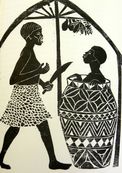Bantu Tales and Fly Eagle Fly: African Cultural Portryals
The first image is from Bantu Tales (1970) by Virginia Holladay and is from the story Tshikashi Tshikulu and the Woman. The images from this book are woodcuts and depict various scenarios from generational stories within African communities of the Congo. Here, we see our main female character as she is about to perform an act of cannibalism on another woman. Africans are very often portrayed in literature and television as savage cannibals and this image exemplifies that stereotype as the female moves toward her intended dinner with a knife and mouth wide open. Granted, these are supposed to be tales passed down from the generations, but the image conveys and perpetuates a negative image of the lives of Africans. What would you remember most if you read the story? The image that you saw related to the story, or the story itself?
In contrast to the other image, this illustration from Fly Eagle Fly: An African Tale (2000), retold by Christopher Gregorowski and illustrated by Niki Daly. In this image we have a group of children who are dressed in a variety of clothing styles, more suitable to the versatlity of African communities. There are no acts of cannibalism being performed and it is conducive from the image that these people eat "regularly" like everyone else as they are surrounded by animals of the commonly eaten kind. This image also makes use of colors unlike the other image which depicts the chracters as solely "black" and dark.


